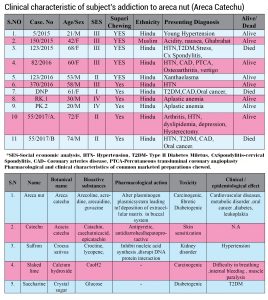AN UNDERRATED THREAT

Areca nut chewing, besides causing cancer in various regions such as mouth, pharynx and throat, also has perilous effects on other organs, thus emerging as a significant risk factor for CAD, hypertension, diabetes and oral cancer….
By Dr Shridhar Dwivedi
Areca nut is the seed of Areca catechu that grows in tropical Pacific, Asia and parts of east Africa. Areca nut chewing is one of the most predominant substances being abused in the world. Areca nut chewing is predominant in South Asia (e.g., India, Pakistan and Nepal), Southeast Asia (e.g., Cambodia, Vietnam, Taiwan, Malaysia, Indonesia, Papua New Guinea, and the Philippines) and the Western Pacific islands. It is used in parts of Melanesia (including the Solomon Islands and New Ireland) and in Micronesia.
nut is the seed of Areca catechu that grows in tropical Pacific, Asia and parts of east Africa. Areca nut chewing is one of the most predominant substances being abused in the world. Areca nut chewing is predominant in South Asia (e.g., India, Pakistan and Nepal), Southeast Asia (e.g., Cambodia, Vietnam, Taiwan, Malaysia, Indonesia, Papua New Guinea, and the Philippines) and the Western Pacific islands. It is used in parts of Melanesia (including the Solomon Islands and New Ireland) and in Micronesia.
Areca nut is often chewed alone or cut in fine pieces wrapped inside betel leaves (paan) or with paan and tobacco both generally known as betel quid. Areca nut is chewed by itself and in various scented preparations. The composition of areca nut varies in different populations and countries. It is fourth most common human self-ordered psychoactive substance after alcohol, caffeine and nicotine. One may defensibly call it a social evil, because its social acceptability is too high in especially various religions in Indian subcontinent. It has strong cultural acceptability unlike to that of other psychoactive substances like tobacco and alcohol cutting across all socio-economic groups in Indian subcontinent.
The active ingredient of areca nut is arecoline that appears to be highly addictive but there is no direct evidence for it. It is possible that areca nut whether taken alone as a cut piece or with anything like pan masala, betel quid may not be addictive but when taken with ingredients mixed or added to areca nut may have addictive effect. It is used in various forms alone or in mixture with tobacco, clove, cardamom etc. Other most common form is pan masala. Areca nut causes colossal damage to human health, affecting primary oral mucosa, dental tissue, oral pharynxand gastrointestinal tract, cardiovascular system (CVS), genitourinary system, hematopoietic system and metabolomics. Its deleterious effects are noticed only at very late stage. However, unlike that of tobacco and alcohol, areca nut remains an under recognized public health issue.
We recently came across several cases suffering with oral lesion combined with cardiovascular disease where areca nut played major role in their etiopathogenesis. This prompted us to review all aspect of areca nut to sensitise medial fraternity, health authorities as well as people at large who become its victim taking into account the damage it inflicts an individual and society.
 SOCIAL ACCEPTABILITY IN INDIAN SUBCONTINENT
SOCIAL ACCEPTABILITY IN INDIAN SUBCONTINENT
The pervasiveness of areca nut consumption with or without tobacco is very high in India because of its social and culture acceptability. In rural areas, it is consumed by about 34.7% of the males as associated with 32.4% of the females. In urban areas, the consumption rate among males is about 37.8% and in females it is about 29.7%. The use of areca nut products is widespread in youths, where 16.4% use it regularly and 13% use it sporadically. Even the well-educated section of the society consumes areca nut, where 12.5% do it regularly and 27.5% do it occasionally. In view of its addictive nature, the use of areca nut is prohibited among Sikhs and Buddhists. In Hindus, because of its socio-cultural acceptability, areca nut is not only chewed alone but also frequently with betel leaf (piper Areca). Muslims and Jains usually do not chew areca nut alone. Interestingly during last fifty years areca nut has become an essential ingredient in most of the popular paan masala and Gutkha items consumed by Hindus and Muslims alike.
 CLINICAL CONSIDERATIONS AND PRELIMINARY CLINICAL STUDIES
CLINICAL CONSIDERATIONS AND PRELIMINARY CLINICAL STUDIES
As consumption of areca nut alone is not mentioned by patients and usually not asked by physicians in routine history, its clinico- pathological effect on human system goes mostly unreported by internists and cardiologists. Most of its adverse effects have been noted by dental surgeons and /or oral cancer surgeons. However, we do come across cardiovascular patients with history of chewing areca nut alone. It is only when they are presented with the evidence of bad oro-dental health, they accept to be chewing areca nut. Unlike smoking, taking areca nut is more common among South-Asian women. This habit is passed down to next generations. Its ill effects are related to cholinergic action of arecoline. Its use can diminish the effects of anti-muscarinic drugs and potentiate the action of other cholinergic agonists, ultimately resulting into a cholinergic toxicity syndrome. Soon after chewing areca nut they demonstrate the inhibitory action of arecoline on GABA because of the antagonism of the anxiolytic effect of benzodiazepam and antidepressants. Other interactions have been found with: amantadine, fenotiazine, olanzapine, molindone, loxapine, aloperidhol. They result in an increase of the extrapyramidal effects.
Areca nut chewing causes deleterious effects manifesting in hypertension, arrhythmia, and coronary artery disease (CAD). However, ST elevation myocardial infarction (STEMI) is an extremely rare impediment of areca nut chewing. It has been reported that areca nut affects the patients grieved from STEMI after areca nut chewing. The first case tangled a patient with non-obstructive CAD and non-sustained ventricular tachycardia during hospitalisation. The second case revealed left circumflex artery total occlusion, and primary percutaneous coronary intervention was attained. Initially, the levels of arecoline and arecaidine in plasma were identified. Arecoline and areca nut hypothesis is related with cardiovascular pathologies. High levels of homocysteine have been reported with chronic uses of betel nut. They are associated with higher risk of ischemic cardiopathies. Arecoline can cause vasospasms in coronaries. In habitual users of areca nut, several incidences of extra systoles have been reported. Tachycardia begins within two minutes from the assumption and lasts at least 20 minutes. This is another evidence of cardiovascular effects of areca nut. The mean heart rate raise diminishes with the increase of frequency of areca nut chewing.
Areca nut is not given during pregnancy and breastfeeding due to the risk of birth faults or unprompted abortion. Areca nut derivative products such as arecoline are able to pass placenta. In the literature there are some cases of newborn babies (born from mothers who chewed areca nut) who presented a lower weight, hypotonia, and interruption of growth. Inquisitively, there was also a lower frequency of neonatal jaundice in these babies.
The use of areca nut can slow and raise heart rate. So, it is possible that it may interact with beta blockers, calcium antagonists and digoxin. Because arecoline can have an effect on sugar levels, caution is advised when using other medications that vary glucose level in blood. The arecoline cytotoxicity and carcinogenic properties are potentiated by the modern use of alcohol and smoking. This is a very pertinent point because many of Indian patients particularly males are addicted to smoking as well as alcohol thus suffering from acute myocardial infarction at a young age because of their addiction to areca nut containing pan masala, smoking and alcohol – all three. The use of arecoline together with caffeine, guarana and ephedra (stimulant herbs) compounds the woes of the patient.
 CONCLUSION
CONCLUSION
Areca nut is a socially acceptable addictive substance in various countries including India. It is widely consumed by all age groups and either sex. Besides causing cancer in various regions such as mouth, pharynx and throat, it also has perilous effects on other systems. Based on preliminary study and literature review, we conclude that areca nut chewing is a significant risk factor for CAD, hypertension, diabetes and oral cancer. Notably, there were many preparations which contain areca nut exclusively. However, possibility of some other addictive toxic material cannot be ruled out in such preparations. It is recommended to initiate systematic chemical analysis of such preparations, followed by clinical study on these formulations. Individually, all additional components (Cardamom, saffron, menthol, saccharine and sugar) appear to be safe. However, it appears that when areca nut is mixed with these constituents, it may lead to oral cancer or CAD. In view of its cardiotoxic actions, there is an urgent need for total ban on areca nut and its preparations in all forms. Further systematic large-scale studies are required to elucidate its role in different vascular diseases.
DISCUSSION
The present study indicates chewing of areca nut leads to the risk of coronary artery disease beside its potential to cause cancer in oral cavity, pharynx, and throat in subjects who chewed areca nut alone or mixed with other deleterious substances. This is corroborated by a Taiwanese study which has reported a linkage between areca nut chewing and cardiovascular diseases in women. Many other studies and one like Lan et al. have reported that elderly people who chewed areca nut had higher risk of mortality ( hazard ratio =1.19, 95% CI: 1.05, 1.) , and cerebrovascular diseases death ( hazard ratio=1.66, 95% CI: 1.19, 2.30 ) , compared with the ones who did not consume areca nut. There are some other studies that support the outcomes in our study. It has also been reported that areca nut causes hypertension, arrhythmia, and CAD. This is also mentioned that homocysteine level increases among chronic users of areca nut. Further several incidences of extra systoles have been reported in habitual users of areca nut. Tachycardia begins within two minutes of its consumption and lasts at least 20 minutes. This is another evidence of cardiovascular effects of areca nut. They are associated to a higher risk of ischemic cardiopathies. Arecoline can cause vasospasms in coronaries. This is probably due to an endothelial damage following arecoline parasympathomimetic action. Damage to endothelial can be considered as one of the causes of CAD. Chronic use of areca nut can cause a decrease in B12 levels in blood and depletion in thiamine and vitamin D. It is not clear if vitamin depletion is due to arecoline or other substances contained in the betel nut preparations.
(The author is Senior Consultant Cardiologist, National Heart Institute, New Delhi)

